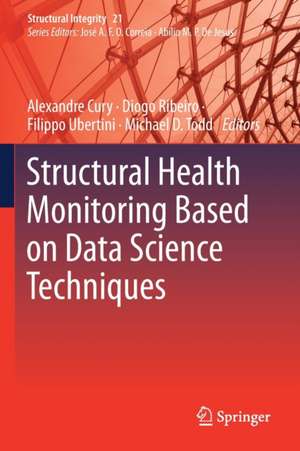Structural Health Monitoring Based on Data Science Techniques: Structural Integrity, cartea 21
Editat de Alexandre Cury, Diogo Ribeiro, Filippo Ubertini, Michael D. Todden Limba Engleză Paperback – 25 oct 2022
| Toate formatele și edițiile | Preț | Express |
|---|---|---|
| Paperback (1) | 997.06 lei 6-8 săpt. | |
| Springer International Publishing – 25 oct 2022 | 997.06 lei 6-8 săpt. | |
| Hardback (1) | 1003.63 lei 6-8 săpt. | |
| Springer International Publishing – 24 oct 2021 | 1003.63 lei 6-8 săpt. |
Din seria Structural Integrity
- 18%
 Preț: 956.69 lei
Preț: 956.69 lei - 18%
 Preț: 1396.43 lei
Preț: 1396.43 lei - 17%
 Preț: 461.25 lei
Preț: 461.25 lei - 24%
 Preț: 1331.37 lei
Preț: 1331.37 lei - 15%
 Preț: 641.38 lei
Preț: 641.38 lei - 18%
 Preț: 1847.84 lei
Preț: 1847.84 lei - 18%
 Preț: 942.76 lei
Preț: 942.76 lei - 15%
 Preț: 699.28 lei
Preț: 699.28 lei - 15%
 Preț: 637.28 lei
Preț: 637.28 lei - 18%
 Preț: 777.69 lei
Preț: 777.69 lei - 18%
 Preț: 1219.63 lei
Preț: 1219.63 lei - 15%
 Preț: 637.13 lei
Preț: 637.13 lei - 18%
 Preț: 940.57 lei
Preț: 940.57 lei - 18%
 Preț: 1223.55 lei
Preț: 1223.55 lei - 15%
 Preț: 637.59 lei
Preț: 637.59 lei - 18%
 Preț: 1562.17 lei
Preț: 1562.17 lei - 18%
 Preț: 1546.68 lei
Preț: 1546.68 lei - 18%
 Preț: 1384.44 lei
Preț: 1384.44 lei - 18%
 Preț: 1111.85 lei
Preț: 1111.85 lei - 18%
 Preț: 1564.23 lei
Preț: 1564.23 lei - 18%
 Preț: 944.99 lei
Preț: 944.99 lei - 18%
 Preț: 957.32 lei
Preț: 957.32 lei - 15%
 Preț: 643.00 lei
Preț: 643.00 lei -
 Preț: 436.35 lei
Preț: 436.35 lei - 18%
 Preț: 1221.51 lei
Preț: 1221.51 lei
Preț: 997.06 lei
Preț vechi: 1246.32 lei
-20% Nou
Puncte Express: 1496
Preț estimativ în valută:
190.78€ • 199.73$ • 157.86£
190.78€ • 199.73$ • 157.86£
Carte tipărită la comandă
Livrare economică 05-19 aprilie
Preluare comenzi: 021 569.72.76
Specificații
ISBN-13: 9783030817183
ISBN-10: 3030817180
Pagini: 484
Ilustrații: XV, 484 p. 313 illus., 268 illus. in color.
Dimensiuni: 155 x 235 mm
Greutate: 0.69 kg
Ediția:1st ed. 2022
Editura: Springer International Publishing
Colecția Springer
Seria Structural Integrity
Locul publicării:Cham, Switzerland
ISBN-10: 3030817180
Pagini: 484
Ilustrații: XV, 484 p. 313 illus., 268 illus. in color.
Dimensiuni: 155 x 235 mm
Greutate: 0.69 kg
Ediția:1st ed. 2022
Editura: Springer International Publishing
Colecția Springer
Seria Structural Integrity
Locul publicării:Cham, Switzerland
Cuprins
Chapter 1. Vibration-based structural damage detection using sparse Bayesian learning techniques (Rongrong Hou).- Chapter 2. Bayesian deep learning for vibration-based bridge damage detection (Davíð Steinar Ásgrímsson).- Chapter 3. Diagnosis, Prognosis, and Maintenance Decision Making for Civil Infrastructure: Bayesian Data Analytics and Machine Learning (Manuel A. Vega).- Chapter 4. Real-Time Machine Learning for High-Rate Structural Health Monitoring (Simon Laflamme).- Chapter 5. Development and validation of a data-based SHM method for railway bridges (Ana Claudia Neves).- Chapter 6. Real-time unsupervised detection of early damage in railway bridges using traffic-induced responses (Andreia Meixedo).- Chapter 7. Fault diagnosis in structural health monitoring systems using signal processing and machine learning techniques (Henrieke Fritz). Chapter 8. A self-adaptive hybrid model/data-driven approach to SHM based on Model Order Reduction and Deep Learning (Luca Rosafalco).- Chapter 9. Predictive monitoring of large-scale engineering assets using machine learning techniques and reduced order modeling (Caterina Bigoni).- Chapter 10. Unsupervised data-driven methods for damage identification in discontinuous media (Rebecca Napolitano).- Chapter 11. Applications of Deep Learning in intelligent construction (Yang Zhang).- Chapter 12. Integrated SHM systems: Damage detection through unsupervised learning and data fusion (Enrique García-Macías).- Chapter 13. Environmental influence on modal parameters: linear and non-linear methods for its compensation in the context of Structural Health Monitoring (Carlo Rainieri).- Chapter 14. Vibration based damage feature for long-term structural health monitoring under realistic environmental and operational variability (Francescantonio Lucà).- Chapter 15. On explicit and implicit procedures to mitigate environmental and operational variabilities in data-driven structural health monitoring (David García Cava). Chapter 16. Explainable artificial intelligence to advanced structural health monitoring (Daniel Luckey).- Chapter 17. Physics-informed machine learning for Structural Health Monitoring (Elizabeth J. Cross).- Chapter 18. Interpretable Machine Learning for Function Approximation in Structural Health Monitoring (Jin-Song Pei).- Chapter 19. Partially-Supervised Learning for Data-Driven Structural Health Monitoring (Lawrence A. Bull).- Chapter 20. Population-Based Structural Health Monitoring (Paul Gardner).- Chapter 21. Machine Learning-Based Structural Damage Identification within Three-Dimensional Point Clouds (Mohammad Ebrahim Mohammadi).- Chapter 22. New sensor nodes, cloud and data analytics: case studies on large scale SHM systems (Isabella Alovisi)
Textul de pe ultima copertă
The modern structural health monitoring (SHM) paradigm of transforming in situ, real-time data acquisition into actionable decisions regarding structural performance, health state, maintenance, or life cycle assessment has been accelerated by the rapid growth of “big data” availability and advanced data science. Such data availability coupled with a wide variety of machine learning and data analytics techniques have led to rapid advancement of how SHM is executed, enabling increased transformation from research to practice. This book intends to present a representative collection of such data science advancements used for SHM applications, providing an important contribution for civil engineers, researchers, and practitioners around the world.
Caracteristici
Presents a collection of data science applied to structural health monitoring applications Includes experimental and field examples of detection and identification approaches Explains how data can be used in the decision-making process of structural maintenance and usage
